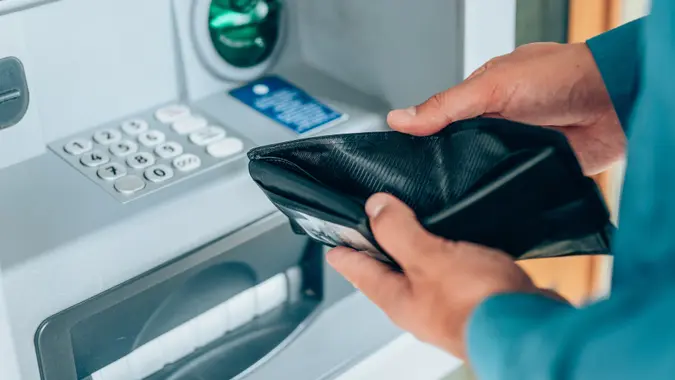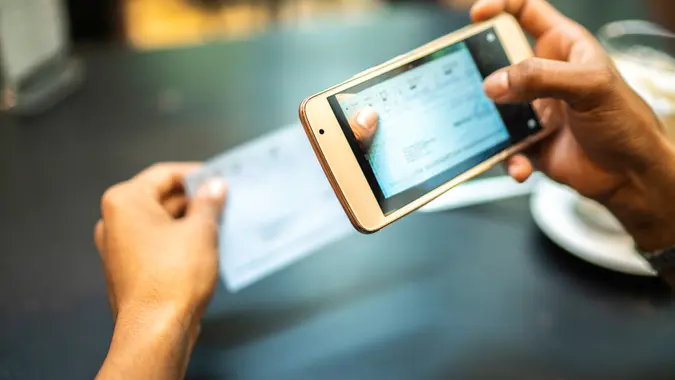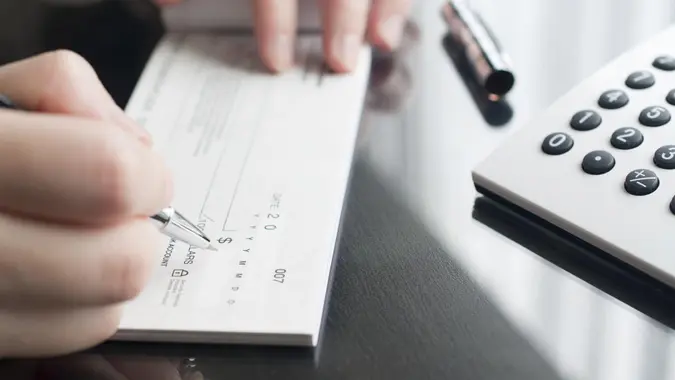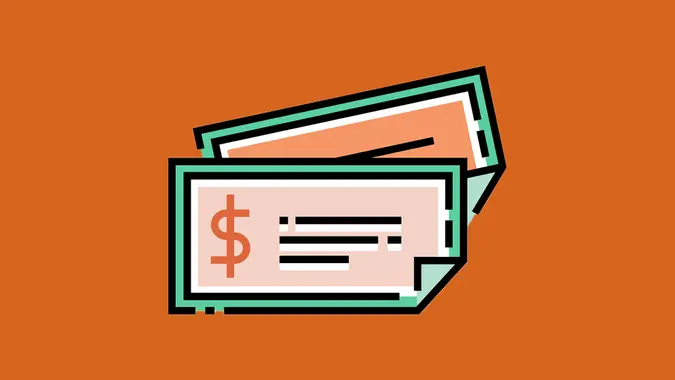Understanding Direct Deposit: How It Works and How to Set It Up

Commitment to Our Readers
GOBankingRates' editorial team is committed to bringing you unbiased reviews and information. We use data-driven methodologies to evaluate financial products and services - our reviews and ratings are not influenced by advertisers. You can read more about our editorial guidelines and our products and services review methodology.

20 Years
Helping You Live Richer

Reviewed
by Experts

Trusted by
Millions of Readers
More than 95% of people in America receive their paycheck through direct deposit, according to an American Payroll Organization survey. Direct deposit is convenient and saves both employees and employers money. Even better, a traditional bank account isn’t required to set it up.
If you’re still dealing with the inconvenience of a paper payroll or government checks, read on. Find out more about what direct deposit is, how it works and how to set it up so you’re prepared to make the switch.
What Is Direct Deposit?
Direct deposit is an electronic transfer of funds from a payer to a payee’s account. You can set up direct deposits with checking or savings accounts, investment brokerage accounts, some prepaid debit cards and payment apps like PayPal.
Direct deposit eliminates the need for paper checks, ensuring greater reliability that funds will be sent and received in a timely manner. Here are some key advantages of direct deposit:
| Features of Direct Deposit | Benefits |
| Fast and convenient | No waiting at the bank and funds are automatically deposited |
| Secure and reduces fraud | Reduces risk of lost or stolen checks |
| Eliminates paper checks | No need to handle checks or deposits manually |
| Ensures timely payment | On-time payments of paychecks, Social Security benefits and tax refunds |
| You can split your direct deposit | You can divide your direct deposit to be credited to multiple accounts |
| Automate payments | You can automate bill pay and save time |
How Does Direct Deposit Work?
Once you set up direct deposit, you will no longer receive a paper check from that payer. Here is what happens instead:
Employer Uses ACH
Your employer or another payer transfers money into your account using ACH — the Automated Clearing House. ACH coordinates the transfer of funds from one bank account to another.
You Choose How To Receive Your Direct Deposit
You can have your entire direct deposit payment go into one account or split it into multiple accounts. For instance, you can deposit part of your paycheck into your checking account and a certain percentage into your savings account.
Availability of Deposit
Once the direct deposit payment is processed and transferred into your account, the funds are typically available that same day. However, some bank and payment apps may make the funds available as soon as the direct deposit is received rather than after it is processed, allowing you to get your money a day or two early.
Common Uses of Direct Deposit
Direct deposit is a secure way to receive payments conveniently. Here are some ways direct deposit is used:
- Payroll for employees. You can receive your wages through direct deposit.
- Government payments and benefits. This includes Social Security and disability benefits, tax refunds and unemployment benefits.
- Retirement and pension benefits. Retirees can receive 401(k), IRA or pension payouts from private and government retirement plans.
- Investment and brokerage payments. You can receive dividends, capital gains and other investment earnings through direct deposit.
- Child support and alimony payments. Many states process child support payments electronically so payment can be received timely.
Benefits of Direct Deposit
There are significant benefits of switching from paper checks to direct deposit including:
Speed. Funds are usually available to you on the same day they are deposited into your account, and many banks and payment apps make the funds available to you in a day or two.
Savings. You can avoid monthly maintenance and bank fees on checking and other accounts by using the account to receive a recurring direct deposit.
Security. Direct deposit is safer than receiving paper checks, which anyone can pluck right out of your mailbox. Paper checks can also be lost or stolen, neither of which is a problem if you have direct deposit.
Convenience. You can receive recurring payments automatically without having to worry about racing home and hoping your check is in the mail. With direct deposit, you can log into your bank account and immediately see if you’ve received funds.
Environmentally Friendly. Direct deposit eliminates the need for paper. You save paper and reduce waste.
How to Set Up Direct Deposit
Setting up direct deposit is easy, but you do have to take a few steps to make certain funds are deposited into your account. Let’s take a look at the steps::
Gather Your Banking Information
You will need to know your bank name, routing number, account number and account type.
Get a Direct Deposit Form from Your Employer
Your employer’s human resource department will likely have a direct deposit authorization form.
Fill Out the Required Information
You will need to enter bank details (routing and account numbers). Confirm the deposit amount and attach a voided check if necessary. Sign and date the form.
Submit the Form to Your Employer
Turn in your form to the HR department.
Confirm and Monitor Your First Deposit
It may take one or two cycles before your first direct deposit will hit your account. Monitor your account to make certain your direct deposit goes through.
Is Direct Deposit Safe?
Direct deposit is not only convenient for employers and employees, but is also a safe way to send and receive funds. The funds are electronically deposited into your bank account. This eliminates the possibility of funds being lost or stolen.
You may be wondering, “What if someone hacks my direct deposit and steals my money?” Financial institutions have security measures to prevent this from happening. Banks use end-to-end encryption to secure data during transmission. Other extra verification measures include multi-factor authentication and fraud detection.
Alternatives to Direct Deposit
What if you don’t want to receive a direct deposit? Are there other options? There are alternative ways to receive your paycheck or other payments.
Physical Checks. Getting a physical check in the mail or in-person is one way to receive payment. However, it comes with risks. The check could be delayed, lost or stolen. A physical check has inherent security risks.
Prepaid Debit Cards. If you don’t have a bank account, you could receive your money through a debit card. For example, your employer could load your paycheck onto a debit card. You can use the card to make purchases, withdraw cash from ATMs, or pay bills online. However, there may be transaction fees, and transferring funds to another account may prove difficult.
Digital Payment Platforms. Employers can use platforms like PayPal and Venmo to deposit your paycheck. You get immediate access to funds without the need of a bank account.
Our in-house research team and on-site financial experts work together to create content that’s accurate, impartial, and up to date. We fact-check every single statistic, quote and fact using trusted primary resources to make sure the information we provide is correct. You can learn more about GOBankingRates’ processes and standards in our editorial policy.
- American Payroll Association. "Q2 What's more important to you, better health benefits or higher."
- Comcast Corporation. "Manage My Dividends - Investors."
- Duke Energy. "Individual Investor Information."
- Pension Benefit Guaranty Corporation. "PBGC Payment Dates."
- Fiscal.treasury.gov. "Direct Deposit (Electronic Funds Transfer)."
- IRS. "Tell IRS to Direct Deposit your Refund to One, Two, or Three Accounts."
- SSA.gov "Social Security Direct Deposit"
- American Bankers Association "ABA Routing Number"
 Written by
Written by  Edited by
Edited by 
























